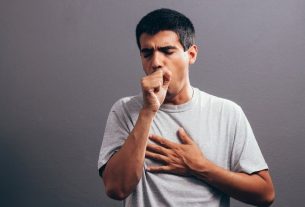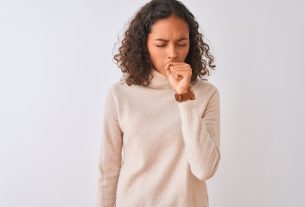Green phlegm can arise due to bacterial infections of the respiratory tract, such as sinusitis, pneumonia, bronchitis or severe COVID-19, and be accompanied by other symptoms such as coughing with thick green phlegm, sore throat, shortness of breath or fever, for example .
The green color of phlegm is the result of the presence of neutrophils in the airways, which are defense cells of the immune system responsible for fighting infections, and which produce a green protein that is dissolved in the mucus, leaving the phlegm green, and the Lighter or darker green color varies depending on the amount of protein. See what each color of phlegm means.
It is important to consult a general practitioner, otorhinolaryngologist or pulmonologist whenever green phlegm appears, so that the cause can be diagnosed and the most appropriate treatment can be started, which is usually done with antibiotics to combat the bacteria.
Main causes of green phlegm
The main causes of green phlegm are:
1. Sinusitis
Sinusitis is an inflammation of the nasal sinuses, which are small cavities in the skull, around the nose and eyes, generally caused by allergic diseases, however, when caused by bacterial infections, it can lead to the accumulation of green phlegm in the nose.
Generally, green phlegm is accompanied by other symptoms such as nasal congestion, fever, headache, pain around the eyes and a feeling of heaviness in the face, for example. Take the test to identify the symptoms of sinusitis.
What to do: A good way to relieve pain behind the eyes caused by sinusitis is to eliminate phlegm from the sinuses by washing the nose with 0.9% saline solution. However, when symptoms last more than 5 days, or are accompanied by fever, phlegm with pus from the nose, and intense pain in the face, a general practitioner or otorhinolaryngologist should be consulted to begin the most appropriate treatment, which may involve the use of antibiotics or nasal sprays
2. Pharyngitis
Pharyngitis is an inflammation of the pharynx, located at the back of the throat, which when caused by infection with bacteria, such as Streptococcus pyogenesfor example, leads to symptoms such as sore throat, green phlegm, feeling of phlegm stuck in the throat, difficulty swallowing, fever and a feeling of scratchy or itchy throat.
Furthermore, other symptoms that may appear are headache, general malaise and hoarseness.
What to do: The treatment of pharyngitis varies according to the symptoms and the cause, and the otorhinolaryngologist may recommend the use of analgesic or anti-inflammatory medications, such as paracetamol or ibuprofen, to reduce pain, fever or inflammation in the throat, or the use of antibiotics to fight bacteria. Furthermore, it is important to rest and drink plenty of fluids during treatment. Check out the main treatments for pharyngitis.
3. Infectious bronchitis
Green phlegm can also appear due to chronic infectious bronchitis, and usually starts with a light color, changing to greenish yellow, due to a bacterial infection.
Other very common symptoms of bronchitis are a cough with thick green phlegm that can last up to 90 days, fever, wheezing, difficulty breathing, shortness of breath and tiredness.
What to do: You should consult a pulmonologist who may recommend the use of medications such as analgesics, anti-inflammatories, expectorant or mucolytic syrups, and antibiotics. See how bronchitis is treated.
4. Pneumonia bacteriana
Bacterial pneumonia is an infection in the lungs caused by bacteria such as Streptococcus pneumoniae, Klebsiella pneumoniae or Staphylococcus aureusfor example, leading to a cough with thick green phlegm, which in some cases may contain blood.
In addition to green phlegm, bacterial pneumonia can also cause other symptoms such as fever, chills, chest pain or difficulty breathing.
What to do: The treatment of bacterial pneumonia is carried out with antibiotics recommended by the pulmonologist according to the type of bacteria that is causing the infection.
5. Pulmonary bronchiectasis
Yellow phlegm can also be caused by pulmonary bronchiectasis, which is a chronic disease characterized by the widening or persistent dilation of the bronchi and weakening of the mucus transport mechanisms, which accumulate in the lungs, contributing to the development of bacterial infection.
One of the main symptoms of bronchiectasis is thick green phlegm, however, other symptoms such as coughing up blood, shortness of breath, general malaise and chest pain frequently appear.
What to do: The treatment of pulmonary bronchiectasis must be carried out by a pulmonologist, to help reduce symptoms and alleviate discomfort, and the use of antibiotics and bronchodilators may be indicated, for example. See how pulmonary bronchiectasis is treated.
6. Cystic fibrosis
Cystic fibrosis is a genetic disease that affects the cells that produce mucus, leading to abnormal production of thick, sticky mucus, which can build up in the lungs, causing recurring lung infections such as pneumonia, and symptoms coughing up thick green phlegm , fever or excessive tiredness.
In addition, other symptoms may appear, such as difficulty breathing, wheezing or shortness of breath.
What to do: The treatment recommended by the pulmonologist must be carried out, which normally recommends the use of antibiotics to combat the infection in the lungs, mucolytic medicines to make the phlegm more liquid, facilitating its elimination, and bronchodilators, to help keep the airways open, relieving the shortness of breath or difficulty breathing. See all treatment options for cystic fibrosis.
7. Lung abscess
Green phlegm can also appear due to a ruptured lung abscess, which is a cavity that contains pus inside due to an infection caused by bacteria such as Staphylococcus aureus, Klebsiella pneumoniae or Streptococcus pyogenesfor example.
Lung abscess generally occurs due to a complication of pneumonia caused by aspiration of the contents of the mouth or stomach, and can progress to necrosis of the lung tissue in one to two weeks, if not treated.
What to do: The treatment of lung abscess is carried out by a pulmonologist with the use of antibiotics, according to the type of bacteria that caused the infection, respiratory physiotherapy, and, in some cases, surgery to remove the necrotic tissue from the lung. Learn more about lung abscess treatment.
8. Exacerbated COPD
COPD, or chronic obstructive pulmonary disease, is an inflammatory condition of the lungs caused by respiratory diseases, such as chronic bronchitis or pulmonary emphysema, which cause the bronchi or bronchioles to close, making airflow and breathing difficult.
Exacerbated COPD can occur due to bacterial pneumonia, leading to symptoms such as coughing with thick green phlegm, rapid and wheezing breathing, wheezing, fever, excessive fatigue and swelling in the legs or ankles.
What to do: The treatment indicated by the pulmonologist must be carried out, which normally includes the use of antibiotics, bronchodilators or corticosteroids, to combat the infection and alleviate respiratory symptoms. See other COPD treatment options.
9. COVID-19 grave
Severe COVID-19 occurs when the SARS-CoV-2 virus reaches the lungs, causing viral pneumonia in one or both lungs, which can occur especially in children, the elderly, or people with weakened immune systems.
Furthermore, COVID-19 can cause bacterial pneumonia secondary to SARS-CoV-2 infection, resulting in symptoms such as cough, green phlegm and fever, which is more common in people hospitalized under mechanical ventilation.
What to do: The treatment of severe COVID-19 viral pneumonia must be carried out in the hospital by a pulmonologist, who may recommend the use of antiviral drugs, such as remdesivir or tocilizumab, for example. In cases of secondary bacterial pneumonia, the doctor must also prescribe antibiotics to combat the bacteria. See the main remedies for COVID-19.
When to go to the doctor
It is important to consult a general practitioner, otorhinolaryngologist or pulmonologist whenever green phlegm appears and is accompanied by other symptoms, such as:
- Fever;
- Chills;
- Blood in the phlegm;
- Cough with phlegm;
- Difficulty breathing;
- Shortness of breathe;
- Easy or excessive tiredness.
In addition, you should seek emergency care or the nearest emergency room if symptoms of low blood oxygenation appear, such as chest pain, bluish lips or fingers, cold sweat, paleness, cold or clammy skin, racing heart, changes in levels of consciousness or mental confusion, especially in the elderly.

Sign up for our newsletter and stay up to date with exclusive news
that can transform your routine!
Warning: Undefined array key "title" in /home/storelat/public_html/wp-content/plugins/link-whisper-premium/templates/frontend/related-posts.php on line 12
Warning: Undefined array key "title_tag" in /home/storelat/public_html/wp-content/plugins/link-whisper-premium/templates/frontend/related-posts.php on line 13




